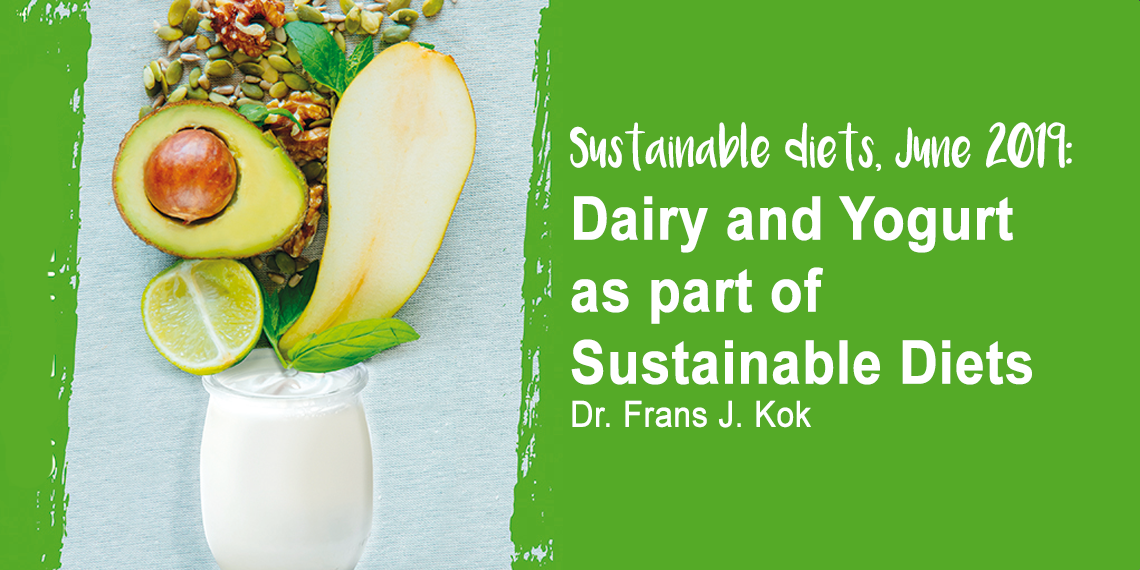Dairy & Yogurt as part of Sustainable Diets by Dr. Frans J Kok (Wageningen University, The Netherlands)
Summary written by Connie Liakos, MS, RDN, CSSD, LD
At the recent Yogurt in Nutrition Sustainable Diets symposium in Baltimore, experts gathered to discuss the impact of diet patterns on the environment. Dr. Frans J Kok discussed the environmental impact of major food categories, the current knowledge on the contribution of dairy and yogurt in a sustainable diet, and directions for future research.
Balancing human health with planetary health
According to Dr. Kok, “the food system is a major driver of greenhouse gas (GHG) emissions, water and land use.” Agriculture accounts for an estimated 24% of GHG with equal contributors from food production, food consumption and food loss/waste. The 2015 Paris climate agreement of 2015 has the goal of keeping global warming 2°C below pre-industrial levels.
At the same time, current dietary patterns in many countries do not provide optimal health benefits. Changing dietary habits and patterns can positively affect both human and planetary health. According to the EAT-Lancet Report, moving towards more plant based and fewer animal based foods can positively affect health and chronic disease risk while lowering our environmental footprint. But first, there is more work to be done regarding the effects of how individual foods, food groups and diet patterns influence both health and the environment.
The food system is a major driver of greenhouse gas (GHG) emissions, water and land use – Dr Kok – YINI Summit “Sustainable Diets, ASN Nutrition 2019”.
What we know about Diet and Greenhouse gas
While animal derived foods contribute to increased GHG emissions, there is a distinct difference in the amount contributed by individual foods and groups. For instance, beef production is considered the biggest contributor to GHG emissions while dairy has a smaller carbon footprint. Even within dairy categories, yogurt and milk have lower carbon footprints than cheese.
Dr. Kok pointed out that in the 2017 paper Eating for 2 Degrees, published by WWF, there was “no constraint on total dairy,” though it did call for a shift away from cheese. The emphasis instead was on decreasing meat-based animal products.
Below is an excerpt from this paper with targets for 2030 in the UK diet.
Eating for 2 degrees in 2030 : the dietary targets
- Beef/Veal – 80% decrease
- Pork – 30% decrease
- Lamb – 37% decrease
- Poultry – 70% decrease
- Processed meats – 58% decrease
- Dairy (overall) – 4% increase
- Cheese – 57% decrease
- Legumes/nuts/oilseeds – 144% increase
While consideration of GHG emissions is an important determinant in dietary guidelines, human nutrient needs and cultural food preferences are also of major consideration. While the production of plant-based proteins has a lower carbon footprint, high quality protein and nutrient-dense foods should also be a consideration in human health. For instance, yogurt contributes high quality protein, probiotics and a wide array of micronutrients.
Gaps in the research
Dr. Kok explained that to date, observational, scenario-based approaches and modeling/optimization strategies have been used to estimate the effect of food categories on GHG emissions. Future research needs to extend beyond summarizing national case studies and instead focus on optimization approaches using individual data on diet patterns. He explained that an optimization approach is one that fulfills both nutrition and environmental targets, promotes diets that are realistic, acceptable and affordable, and also accounts for technological innovations.
While the evidence is scarce, early results indicate that dairy plays a moderate role in GHG emission and future research should explore specific dairy products. Most studies to date have focused on total dairy rather than analyzing individual dairy products. For instance, cheese is considered to have a greater environmental impact than yogurt or milk but further evaluation is needed.
Take-home messages from Dr. Frans J Kok’s presentation
- Kok does not recommend approaching dietary changes by eliminating foods or entire food categories. Instead, reducing foods with high environmental impact while substituting more plant-based foods will be more effective in achieving dietary guidelines with positive environmental impacts.
- Always consider the culture surrounding food choices when making decisions about dietary guidelines.
- Dairy has a moderate effect on GHG emissions while providing high quality nutrition. A daily intake up to 500 grams of milk or derivative equivalents, e.g. yogurt, fits into sustainable and healthy diets.
- Yogurt is of particular interest, because it is a low-fat nutrient-dense food and contributes healthy bacteria to the gut.
- Research is needed to further quantify the specific environmental impact of yogurt.
Sources:
- Sustainable Diets. Leaflet with abstracts from the Nutrition 2019 Symposium in Baltimore, MD. Yogurt in Nutrition Initiative.
- Willett W, Rockström J, Loken B, et al. Food in the Anthropocene: the EAT–Lancet Commission on healthy diets from sustainable food systems. The Lancet. 2019;393(10170):447-492.
- WWF UK (2017). Eating for two degrees.
- Chen, Canxi & Chaudhary, Abhishek & Mathys, Alexander. (2019). Dietary Change Scenarios and Implications for Environmental, Nutrition, Human Health and Economic Dimensions of Food Sustainability. Nutrients. 11. 856. 10.3390/nu11040856.
Summary written by Connie Liakos, MS, RDN, CSSD, LD (Twitter: @nutritionkids)



